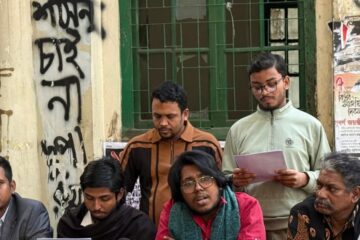In the tranquil hills of Sajek union, Chittagong Hill Tracts (CHT), life usually follows a steady rhythm of jum cultivation, the traditional shifting farming system sustaining families for generations. But in September 2025, that rhythm was abruptly broken.
Overnight, countless rats swarmed through the terraced slopes, devouring paddy, the main staple, and cash crops such as turmeric, ginger, cotton, sesame, and vegetables. Within days, once-green fields turned barren, wiping out the year’s harvest and the next season’s hope.
Locals call it indur bonnya, the “rat flood,” a recurring but unpredictable natural disaster that rises not from rivers, but from forests.
“This year’s harvest looked so good,” said a farmer in Hachchya Para. “But the rats took everything. Now, there’s nothing left.”
The science behind the rat flood
Despite its folkloric name, the rat flood is a recognized ecological event linked to the life cycle of the Muli bamboo (Melocanna baccifera). According to Govindan et al in Nature, once every 45–50 years, millions of these bamboo plants flower simultaneously in a phenomenon known as “gregarious flowering” or “bamboo masting,” releasing vast quantities of protein and starch-rich seeds.
As noted in Rodent Outbreaks: Ecology and Impacts, this sudden food abundance triggers a demographic explosion among forest rodents, creating an “ecological cascade.” In Bangladesh’s hill tracts, in 2010, it was documented that rodent breeding becomes continuous when bamboo seeds are plentiful.
When the seeds are exhausted, the inflated rat population faces starvation and invades Jum fields, granaries, and homes, thus beginning the rat flood, a tide that drowns livelihoods rather than land.
Why so sudden and so rare?
The Muli bamboo follows a biological clock, flowering only once every few decades, often across vast areas at once. The last cycles occurred in the 1950s and mid-2000s; the current one began in Mizoram, India, around 2022 and reached Rangamati in 2025.
Shoubha Rani Chakma (63) recalled a similar rat flood from her youth: “We work all year hoping to harvest rice in Bhadra, but just as it ripens, rats cut the rice heads like scissors. Within a night, everything is gone.”
As the affected areas of Sajek are remote and near the Indian border, news of the devastation reached the public late.
Sajek 2025: When the rats came
The 2025 outbreak began in early September after widespread bamboo flowering in the surrounding hills. Villages like Sioldai, Hachchya Para, Jam Para, Arun Para, and Lungtian Para were the worst hit.
A rapid assessment by Caritas Bangladesh found that at least 466 families across 13 villages lost most of their crops, while vegetables and cash crops were completely destroyed. For Chakma and Tripura communities dependent on Jum farming, this meant months of food shortage and financial strain.
“I cultivated five acres but harvested only 160 kilograms of rice,” said a farmer from Lungtian Para. “The rats left us with nothing but empty fields.”
Interestingly, neighbouring areas with fruit gardens or mixed farming suffered less damage. Scientists note that proximity to flowering bamboo forests determines the severity of infestation, showing how geography and ecology interact.
Why only in the hill tracts?
The rat flood is largely confined to the CHT because its dense bamboo forests create ideal breeding grounds during flowering cycles. In contrast, Bangladesh’s plains, with mixed vegetation, mechanized farming, and less dense muli bamboo forest, rarely face such outbreaks.
For farmers, devastation often depends on whether their fields lie beside a flowering bamboo grove. Villages like Shiyaldai and Arun Para, at the forest’s edge, were stripped bare overnight, while nearby orchards survived.
The disaster doesn’t strike an entire region uniformly; it moves like a silent ecological wave, hitting where bamboo blooms and human defenses are weak.
A historical pattern
Similar rat outbreaks have occurred in Mizoram, India, and Chin State, Myanmar, after bamboo flowering. Between 2006 and 2008, Mizoram lost over 60% of its crops in a famine known as Mautam.
Historical records from Bangladesh show comparable events in 1958 and 2007, both following bamboo flowering. These patterns highlight that bamboo ecosystems transcend borders, their biological clocks synchronized across nations. Early warning in one country could protect another, yet such cross-border ecological monitoring remains limited.
Beyond crops
The rat flood’s impacts reach far beyond crop loss. Families face empty granaries, loss of income from crops like turmeric and ginger, and food contamination by rodents. Without seeds, the next cultivation cycle falters.
Many take loans, sell livestock, or migrate temporarily, turning an ecological event into a humanitarian crisis marked by hunger, debt, and uncertainty.
Over time, Jum cultivation has also changed. Once sustainable with long fallow periods, it now suffers from shortened cycles due to population pressure and land scarcity, leading to declining soil fertility and erosion. Amid this fragile situation, the rat flood deepens their vulnerability.
Minimizing the damage
While the rat flood is a natural ecological cycle, its human toll can be reduced through research, preparedness, and cooperation.
Understanding science is the first step. Since bamboo flowering follows predictable intervals, long-term monitoring across Bangladesh and neighbouring India could forecast potential outbreaks years in advance.
Integrating such ecological monitoring into the national disaster management system, much like flood or cyclone warnings, could alert communities early.
At the local level, community seed banks protected from rodents can safeguard future harvests, while village food banks provide immediate relief. Environmentally safe rodent control and community pest-management strategies can further reduce losses without harming forest ecosystems.
Given that nature’s boundaries cross political lines, regional cooperation among Bangladesh, India, and Myanmar is vital. Shared data and early-warning systems could prevent localized outbreaks from becoming regional crises.
These combined scientific and community-based actions can turn vulnerability into resilience, enabling hill communities not just to survive the next rat flood, but to face it with preparedness and confidence.
Looking ahead
The rat flood reminds us that not all disasters come with storms or floods. Some, like this one, begin quietly in the forest. The 2025 crisis in Sajek proves that disasters can be biological and ecological as much as climatic.
To protect communities, science must meet local wisdom, combining satellite observation with farmers’ traditional knowledge of forest signs. As the world focuses on climate adaptation and ecosystem-based resilience, the rat floods are a wake-up call. Resilience is not only about reacting to nature but understanding and preparing in harmony with it.
As the farmers of Rangamati replant and rebuild, one truth resonates through the forests: To live with nature, we must not only respond, but we must also learn to foresee.
Inmanuel Chayan Biswas is a Program Officer, Disaster Management (DM), Caritas Bangladesh.



